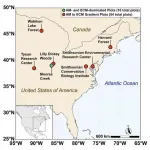"Many studies have shown that there are disparities between the outcomes of black and white patients, but have done little to elucidate why these disparities are occurring," said Chandler Annesi, a medical student from Boston University School of Medicine in Massachusetts. "As we show in our research, segregation, the resulting devaluation of black communities, and other downstream factors have led to wide disparities in lung cancer outcomes."
For this study, Annesi, Michael Poulson, MD, and colleagues from Boston Medical Center in Massachusetts examined data from 193,369 white and 35,649 black patients who were diagnosed with non-small cell lung cancer (NSCLC) from 2004 to 2016 and living in one of the 100 most populous US counties. This information was obtained from a database of the Surveillance, Epidemiology, and End Results Program and National Cancer Institute.
An important demographic measure that researchers used was the index of dissimilarity (IoD), which establishes the "evenness" with which two groups are distributed across geographic areas. According to Annesi, the IoD helped determine the impact of segregation on stage at presentation, surgical resection, and survival.
"We show that disparities between black and white patients can be explained by the level of segregation of the county in which they live," said Dr. Poulson. "This is likely representative of factors like poverty, access to health care, and social mobility, which particularly affect black individuals in more segregated areas."
The researchers found that with increasing residential segregation, black patients were 30% more likely to be diagnosed with advanced stage NSCLC than white patients. Additionally, black patients had a 47% decreased likelihood of receiving surgery (one of the most common and effective treatments for early stage NSCLC), while white patients had an 18% decreased likelihood with increasing residential segregation.
"This study is a very novel contribution to the literature," said Thomas K. Varghese Jr., MD, MS, from the University of Utah in Salt Lake City, who was not directly involved in this research. "For too long, we've known that irrespective of the disease categories, minorities in general have worse outcomes. They also have more morbidity and more mortality. The outcomes just aren't the same. This particular study is an exploration into the why. Why is this occurring? And, uniquely the authors point out that where you live makes a huge difference in terms of cancer treatment outcomes, and we need to do something about it."
The results also demonstrated that median cancer-specific survival significantly differed between black patients in more segregated areas (10 months) and those in less segregated areas (12 months). The cancer-specific survival for black patients when compared to white patients was 10 months and 13 months, respectively.
"Black patients are more likely to die stage-for-stage when compared to their white counterparts. However, it is important to note that this increased mortality is based on discrimination, not on genetics, as we show in our study," said Dr. Poulson.
The study revealed that residential segregation and, ultimately, discriminatory practices reach into the health care system and impact the outcomes of black patients, but the underlying reasons for these complex and deep-seated lung cancer care disparities still are not fully understood.
According to Annesi, a long history of discriminatory practices have forced black Americans into blighted areas and the effects are still apparent today.
In general, people with lower socioeconomic status face more barriers and systemic-level issues, including poor access to high-quality health care, lack of insurance, limited availability of appropriate facilities, lower screening rates, delays in treatment after diagnosis, and lower treatment adherence.
"All of these factors are related to the discriminatory policies that lead black Americans to be more vulnerable to these conditions," said Annesi.
While many black patients live in urban areas with large hospital systems nearby, insurance coverage can greatly limit their ability to access that care. This is particularly apparent in states that do not have expanded Medicaid, leading to many individuals--who are disproportionately black--going without coverage, explained Annesi. The cost of transportation or lack of work flexibility also may preclude their ability to seek care. Similarly, copays (even small ones) may be burdensome for families that are barely able to afford groceries.
Another important factor is the financial distress that is associated with cancer management, which often prevents adequate care--starting prior to diagnosis, during imaging, and through treatment. The costs of care and the impact of some treatments on employment/disability are especially burdensome to those patients who are socioeconomically disadvantaged.
"Disparities are created and as such can be dismantled," said Annesi. "While it will take time and willingness to reverse discriminatory policies that have led to the disparities that we see today, health care teams can use this information to understand the unique barriers that black patients may face."
Addressing Barriers to Care and Raising Awareness
Importantly, physicians and all members of the health care team must become part of the solution and advocate for their patients at every level (individual, state, and federal). This involves identifying at-risk patients, particularly in "minoritized and marginalized" communities (especially those who are uninsured) and making sure they are prioritized within facilities offering discounted or free care. Also essential is working to make lung cancer screening available and convenient. "Simply catching disease at an earlier stage can vastly improve mortality," said Annesi.
Community cancer centers could help rectify some of the logistical challenges that patients face when they live in areas where access to care and lung screening is limited. However, Annesi explained that the centers would have to provide much of the care that the patients need (i.e., imaging, labs, treatment options) in order to be successful and limit the barriers that patients would face if required to travel elsewhere.
An integrated, multipronged approach is another "extremely important" strategy that may help reduce treatment and outcome gaps between black and white patients with lung cancer, according to Annesi. This type of intervention may include a "warning" system connected to electronic health records that sends alerts about missed appointments or milestones to the health care team. Also part of this strategy would be consistent communication among the various clinical teams, as well as relationships and open lines of communication between trained nurse navigators and patients.
"It is important to realize that race matters, and for patients and families, particularly black individuals, to know that lung cancer is not one's fault," said Annesi. "Years of discrimination have set up the background for these disparities, and it is imperative that hospitals and clinics address the difficulties that some patients too often encounter."
Structural racism is defined as the macrolevel systems, social forces, institutions, ideologies, and processes that interact with one another to generate and reinforce inequities among racial and ethnic groups.
INFORMATION:
For more information, contact Jennifer Bagley, Senior Media Relations Manager, at 312-202-5865 or jbagley@sts.org.
Founded in 1964, The Society of Thoracic Surgeons is a not-for-profit organization representing more than 7,500 cardiothoracic surgeons, researchers, and allied health care professionals worldwide who are dedicated to ensuring the best possible outcomes for surgeries of the heart, lung, and esophagus, as well as other surgical procedures within the chest. The Society's mission is to advance cardiothoracic surgeons' delivery of the highest quality patient care through collaboration, education, research, and advocacy.

